Tech notes
Haystack Ultrawideband Satellite Imaging Radar
A ground-based, long-range, dual-band sensor that can daily generate very-high-resolution radar images of space objects has the potential to significantly improve our knowledge of the space environment.
 The completed Haystack Ultrawideband Satellite Imaging Radar is enclosed in a space-frame radome.
The completed Haystack Ultrawideband Satellite Imaging Radar is enclosed in a space-frame radome.Since the launch of satellites into Earth orbits more than 50 years ago, space has become crowded. Commercial and military satellites, both active and defunct, share the space environment with an assortment of space debris, such as remnants of damaged spacecraft and spent rocket boosters. This profusion of orbiting objects could seriously threaten space assets, such as the International Space Station or NASA's science missions such as the Hubble Space Telescope. Moreover, the global proliferation of satellites for communications, geospatial navigation services, and environmental monitoring is making the safeguarding of space and spacecraft more challenging than ever before.
Necessary to protecting the integrity of the space environment is accurate space situational awareness—that is, knowledge of the identity, location, behavior, and capabilities of objects orbiting in space. Providing such awareness is the mission of the U.S. Space Surveillance Network (SSN), a network of optical and radar sensors that detect, track, and collect data to characterize objects orbiting Earth.
The Haystack radar facility in Westford, Massachusetts, originally built in the 1960s as a research test bed, has been a contributing sensor to the SSN since 1979, when the system was advanced to enable long-range imaging. In 2013, a major upgrade to the facility was completed, adding a millimeter-wave W-band radar capability to Haystack's X-band system.
The new dual-band system, the Haystack Ultrawideband Satellite Imaging Radar (HUSIR), is the highest-resolution, long-range sensor in the world, simultaneously generating X- and W-band images that help better determine the size, shape, orientation, and motion of objects orbiting Earth. In addition, HUSIR can characterize individual components of large, complex objects and can distinguish small objects from each other. These advanced capabilities can supply data valuable for improving space situational awareness.
Overcoming Challenges to Dual-Band Operation
Achieving HUSIR's W-band capability required the development and construction of a new Cassegrain antenna.
- The 120-foot-diameter antenna was completely rebuilt to provide a 100 µm root-mean-square (rms) surface accuracy to support operation at the 3 mm wavelength (W band) under all environmental conditions.
- The HUSIR design enabled the control necessary for the antenna to track a satellite with 0.5 millidegree accuracy.
- The replacement of the old antenna with a new structure had to be accomplished without compromising the integrity of the 150-foot-diameter radome that enclosed Haystack. In the 1960s, the radar system had been constructed inside a completed radome. In the 2010s, this radome was partially dismantled (uncapped) to allow removal of the old antenna dish and installation of the new dish and backstructure onto the existing pedestal.
 The new HUSIR backstructure with its quadrapod is lowered through the uncapped radome in preparation for integration with the yoke structure.
The new HUSIR backstructure with its quadrapod is lowered through the uncapped radome in preparation for integration with the yoke structure.Several technological challenges presented by the HUSIR project were met with innovative solutions:
- HUSIR's bandwidth and sensitivity requirements could not be met with RF amplifiers commercially available at the program's start. The Laboratory, in conjunction with Communications & Power Industries of Palo Alto, California, developed a W-band gyrotron traveling-wave tube (gyro-TWT) for the final amplifier stage, leveraging solid-state amplifiers to drive the gyro-TWT. The gyro-TWT operates at 35 kV, uses a solid-state high-voltage modulator, and employs a high magnetic field to control the electron beam.
- The advanced W-band transmitter has 8 GHz instantaneous bandwidth and power to track and image satellites in low Earth orbit.
- Simultaneous W- and X-band operation requires separate signal processing chains for each band. Many advancements in signal processing hardware and algorithms were developed to accommodate W-band operation:
- Lincoln Laboratory developed new signal processing techniques to compensate for the effects of W-band electromagnetic wave propagation through the troposphere.
- The signal processing system leveraged Lincoln Laboratory's Radar Open Systems Architecture (ROSA) to greatly reduce cost and schedule duration. The ROSA real-time operating system, which includes more than half a million lines of code, was used with only slight modifications to accommodate the unique features of HUSIR.
- A new higher-frequency, wider bandwidth waveform generator was designed to have the stability and precision to meet HUSIR's stringent processing sidelobe requirements.
 The gyro-TWT resides in a high-voltage enclosure in a building adjacent to the radome.
The gyro-TWT resides in a high-voltage enclosure in a building adjacent to the radome.Future Directions
The unique dual-band HUSIR system will play key roles within the SSN and the scientific community. Increasing the output power of the W-band transmitter will greatly enhance HUSIR's capability to identify and characterize objects in the geosynchronous-orbit regime. HUSIR will also serve as a test bed for new or improved technologies in radar design and operation. In addition, the HUSIR antenna accommodates scientific instruments and is used by the MIT Haystack Observatory as a radio telescope on a time-available basis. The highly accurate surface of the new antenna enables operation in the 230 GHz band, in which there is considerable scientific interest.
Posted September 2014
top of page